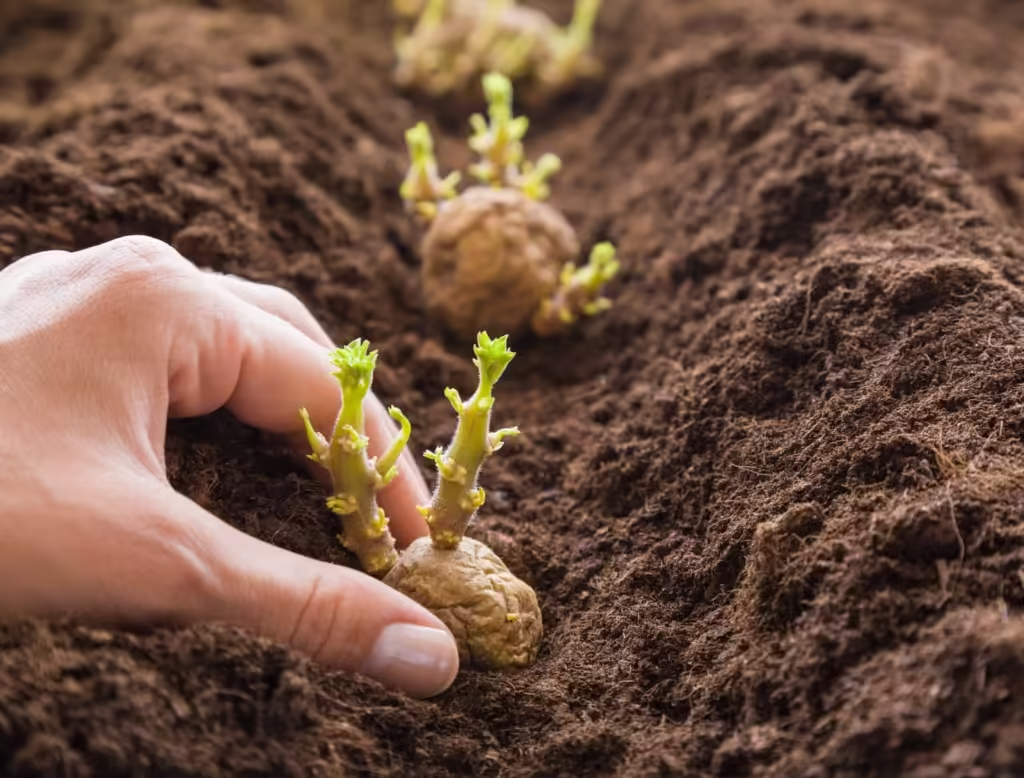Potato growing method
There are several varieties of potatoes, and choosing the right variety is the first step for the success of cultivating the crop and its productivity, and in general it is necessary to choose a variety that fits the conditions of the region in which it is to be grown, in addition to making this variety marketable, and potato varieties differ in many characteristics, the most important of which are: the yield that can be obtained After marketing the potato crop, which depends on the ability of the variety to produce, the color of the potato from the outside and from the inside, and its ability to resist diseases and pests, in addition to the composition of carbohydrates in it, which includes both starch and sugar, which are among the most important characteristics that should be taken into account when choosing The variety, as the best variety has a high percentage of starch and a low percentage of sugars; Like glucose and fructose. [1]
Attention is paid to starch because it indicates the presence of dry matter and the specific gravity of potatoes, as 60% to 80% of dry matter is present as starch, varieties that have specific gravity are rich in starch, and the percentage of starch affects the texture of potatoes, and the extent of their oil consumption during cooking, When frying potatoes, oil replaces the water in potatoes. The varieties that contain a large percentage of dry matter and have a greater specific gravity absorb the oil less than the varieties that contain less dry matter and have less specific gravity, so the food is more healthy, and it is possible to know the relationship between The dry matter of the tuber, the specific gravity, and the optimal use of it according to the following table: [1]
Attention is paid to the percentage of sugars in potatoes, the most important of which are glucose and fructose because they affect the color of potatoes after processing them. Potatoes that contain a high percentage of sugars turn brown when frying, so it is important to choose potatoes with a low percentage of sugars for use as French fries. Or as chips, and the proportion of sugars in the tuber is 3% of the total dry matter. [1]
There are several varieties of potatoes with different characteristics, and among these varieties are the following: [2] Atahualpa: This type originated in Peru, and is suitable for baking and frying. Nicola: This variety grows in the Netherlands, and is ideal for boiling and suitable for salads. Russet Burbank: The classic American potato, suitable for baking and frying. Kipfler: This variety originated in Germany, and is suitable for salad. Maris Bard: Originated in the UK, this variety is suitable for boiling. Spunta: one of the varieties used frequently in both the Kingdom of Saudi Arabia and the Mediterranean countries, with the exception of Turkey. [3]
Land selection
Potatoes need a cold climate in order to grow, but in hot regions, they can be grown in the winter because they do not tolerate heat, but rather they are resistant to light frosts. Rain water, as the soil’s need of water can be provided in an appropriate amount regardless of its type. [5] Among the types of soil in which potato tubers can be grown are the following: [5] Organic soil: This soil is rich in organic materials that help produce quality potatoes High. Clay soil: This soil needs special attention for the success of planting potatoes in it, as it is necessary to rotate crops in it and not plant one type of crop every year, in addition to choosing an appropriate time of the year to cultivate the soil and maintain its productive capacity. Sandy soil: This soil contains a low percentage of organic matter, and in general sandy soils have a weak structure for agriculture, but if this soil is properly irrigated and an adequate amount of water, in addition to providing it with adequate organic materials, it becomes capable of producing a variety of potato varieties. It is of high quality for cooking, but sandy soil is usually exposed to erosion due to the wind, as it is loose soil, so it is important to cover crops with special cover, and rye grains can be planted after harvest to reduce erosion.
There are a number of conditions that must be met in the soil for the success of the potato harvest, as follows: [5] The soil must be of an adequate depth. The soil is loose. The soil should have good drainage of water. The soil should be of high moisture without reaching the saturation stage. The soil must be well ventilated, so that it can exchange gases with the atmosphere, and one of the most important gases that the potato plant needs for growth is oxygen gas, as it increases the ability of the roots to absorb water and nutrients from the soil effectively.
![]()

